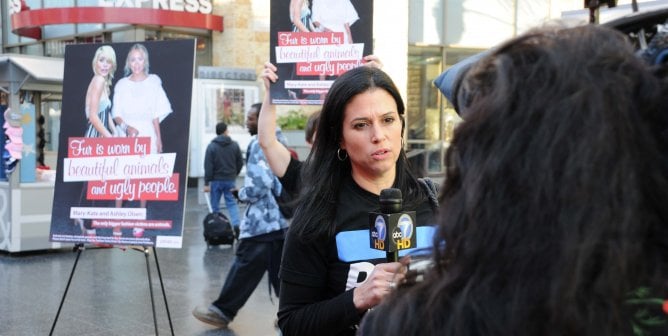Criminal Probe Sought: Calf Skinned Alive and Discarded
For Immediate Release:
May 14, 2020
Contact:
David Perle 202-483-7382
PETA is calling for a criminal investigation of Gourmet Natural Meats outside Lynden, where a U.S. Department of Agriculture report from April reveals that a calf was skinned alive, doused with a chemical, and found calling out underneath five dead calves. In March, a worker dragged a newborn calf by the tail before pushing the animal off a transport trailer. In a letter sent this morning, PETA asks Whatcom County Prosecuting Attorney Eric J. Richey to review the matter and, as appropriate, file criminal cruelty-to-animals charges against the facility and the workers responsible for the incidents.
“Any decent person would be deeply disturbed to learn that a skinned calf at Gourmet Natural Meats was found crying out under a pile of discarded bodies,” says PETA Senior Vice President Daphna Nachminovitch. “PETA is calling for a criminal investigation and urging everyone who objects to this cruelty to go vegan and help prevent more animals from suffering in slaughterhouses.”
PETA—whose motto reads, in part, that “animals are not ours to eat”—opposes speciesism, which is a human-supremacist worldview. The group notes that calves, sheep, pigs, chickens, and other animals feel pain and fear and value their lives, just as humans do, and that the only way to help prevent them from suffering in slaughterhouses is not to eat them.
For more information, please visit PETA.org.
PETA’s letter to Richey follows.
May 14, 2020
The Honorable Eric J. Richey
Whatcom County Prosecuting Attorney
Dear Mr. Richey,
I hope this letter finds you well. I would like to request that your office (and the proper local law enforcement agency, as you deem appropriate) investigate and file suitable criminal charges against Gourmet Natural Meats LLC and the worker(s) responsible for skinning and pouring a chemical on a conscious calf later found buried under dead animals, and dragging a calf by the tail and pushing the animal off a truck before roughly handling others on two recent dates at its slaughterhouse located at 8168 Bob Hall Rd. outside Lynden. The U.S. Department of Agriculture’s Food Safety and Inspection Service (FSIS) documented the incidents in the attached reports, which state the following:
April 17, 2020: “[T]he CSI [Consumer Safety Inspector] went to the area adjacent to the truck unloading site to verify the prompt denaturing of multiple bob veal calves [who] had been discarded as plant rejects prior to the arrival of Inspection Program Personnel on site. … According to a plant manager these rejected calves were all euthanized with a hand-held captive bolt (HHCB) device prior to being unloaded and stacked on a [pallet]. When the CSI arrived, he noted that a calf in the middle of the pile and buried underneath about 5 dead calves was moving and breathing rhythmically. As the CSI examined this calf’s head, which was sticking out from the pile, the CSI observed that the calf was blinking and exhibiting conscious eye tracking. The CSI immediately informed a plant manager of the finding, and a nearby plant employee headed to the stunning area within the slaughter floor to retrieve the establishment’s HHCB device. The CSI then elicited an intact palpebral reflex from the calf, observed the calf lift its head, and went to alert the SPHV [Supervisory Public Health Veterinarian] of the situation. As the SPHV arrived at the area, a conscious vocalization was heard. IPP observed a successful first stunning attempt being applied, and the calf was rendered effectively unconscious. … IPP also discovered that this calf’s hide had been cut and reflected on the left lateral surface of its body wall prior to the observed stunning. Skin was absent from the area of the calf’s left hip to the calf’s left caudal shoulder, and denaturant was present on the underlying tissue.”1
March 12, 2020: “[T]he SPHV observed an individual unloading calves on his own. … The SPHV observed the individual unloading calves holding a sternally-recumbent calf by the tail and dragging it from the middle area of the trailer to the open tailgate. He then pushed the calf off the back of the trailer. Though this calf landed in a standing position, the distance from [the] trailer bed to the ground was approximately 2.5 to 3 feet. When the SPHV arrived at the back of the trailer, the individual unloading calves was roughly jostling another recumbent calf with his foot. The SPHV immediately told him that calves must be handled so as to minimize excitement and discomfort, and that dragging conscious animals is unacceptable. … The same individual unloading calves then forcefully pushed a couple more calves into the pen area and closed the gate.”2
This conduct appears to violate Wash. Rev. Code § 16.52.207(1). Importantly, FSIS action does not preempt criminal liability under state law for slaughterhouse workers who perpetrate acts of cruelty to animals.3
Please let us know what we might do to assist you. Thank you for your consideration and for the difficult work that you do.
Sincerely,
Colin Henstock
Assistant Manager of Investigations
[1]FSIS District 15 Manager Valerie Clay, Reinstatement of Suspension, Gourmet Natural Meats LLC (Apr. 17, 2020) https://www.fsis.usda.gov/wps/wcm/connect/0da44a3d-415f-4a43-9296-caff6db5747a/m46547-ros-04172020.pdf?MOD=AJPERES.2FSIS District 15 Manager Valerie Clay, Notice of Suspension, Gourmet Natural Meats LLC (Mar. 12, 2020) https://www.fsis.usda.gov/wps/wcm/connect/e3ed766f-b980-4f4a-9945-077ac762afcf/m46547-nos-031220.pdf?MOD=AJPERES.
3See Nat’l. Meat Assoc. v. Harris, 132 S. Ct. 965, 974 n.10 (2012) (“. . . States may exact civil or criminal penalties for animal cruelty or other conduct that also violates the [Federal Meat Inspection Act (FMIA)]. See [21 U.S.C.] §678; cf. Bates v. Dow Agrosciences, LLC, 544 U.S. 431, 447 (2005) (holding that a preemption clause barring state laws ‘in addition to or different’ from a federal Act does not interfere with an ‘equivalent’ state provision). Although the FMIA preempts much state law involving slaughterhouses, it thus leaves some room for the States to regulate.”).


